Are you a stargazing enthusiast looking for the best time to visit Big Bend National Park for stargazing? Suppose you’re planning a trip to this National Park to see the Milky Way with your naked eye. Spring, Fall, and Winter are the best seasons to visit this outstanding location for gorgeous stargazing.
The best time is Winter when the skies are clear, and the air is dry. Winter is when the Park is at its least crowded, making it the perfect time to escape the hustle and bustle of everyday life and experience the beauty of the night sky.
In this article, you get
An overview of Big Bend National Park
A look at stargazing in the various seasons in the Park
Big Bend Milky Way photos
Suggestions for the best places for Big Bend stargazing
Tips on building a perfect itinerary for Big Bend National Park stargazing
Info on when to visit Big Bend National Park
By the end of the article, you’ll know the best time of year for stargazing Big Bend and more.
Let’s dive right in.
WHEN IS THE BEST TIME TO VISIT BIG BEND FOR STARGAZING?
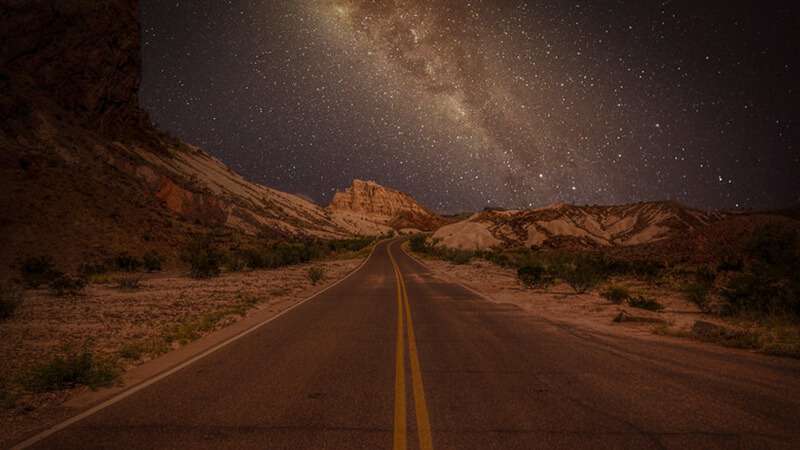
Spring, Fall, and Winter are all excellent times of the year to visit Big Bend National Park for an impeccable stargazing experience. The weather is delightful during this time for you to relish ethereal views of meteor showers, star clusters, and the Milky Way. By the way, have you ever wondered if the Milky Way orbits anything?
When is the best time to stargaze? April and October are the most suitable months to visit Big Bend National Park. During these months, temperatures will be mild, and you’ll enjoy fantastic Big Bend star gazing.
Winter, Spring, and Fall are considered good times for star gazing Big Bend. Many astronomers refer to these months as the “observing season.” This time is typically between the clocks “fall back” in October to when they “spring forward” again in March.
The best time of year for stargazing in Big Bend is during Big Bend Milky Way Season.
SPRING
The best time of year to behold the Milky Way with the naked eye starts in February. Spring Break is an excellent time of year to visit Big Bend National Park to explore star clusters and lush vegetation.
Typically on nights with a new moon, you may find popular stargazing spots and parking lots a little crowded. This is due to the pleasant environment in the spring season in Big Bend Park.
FALL
Mild temperatures, bright sunny days, and slightly chilly evenings are the main draws of the fall season in this remote Park. Fall is a great time to stargaze in a tranquil atmosphere, as fewer crowds head over to this Park during this season.
Late fall on a clear night offers incredible stargazing without the high temperatures of Summer.
WINTER
It’s important to understand that the cold temperatures in Winter are far superior to the heat of the summer months.
In the Winter, you will have a view of clear skies, perfect for seeing dazzling stars, bright planets, and perhaps a streaking meteor. Temperatures swings from 25–40 degrees are possible in this region of Texas.
Remember to bring your winter coat if you plan to stargaze on these cold winter nights. Light snowfall might occur in December.
To help plan your trip, read my article on what you should take with you to go stargazing.
BIG BEND NATIONAL PARK
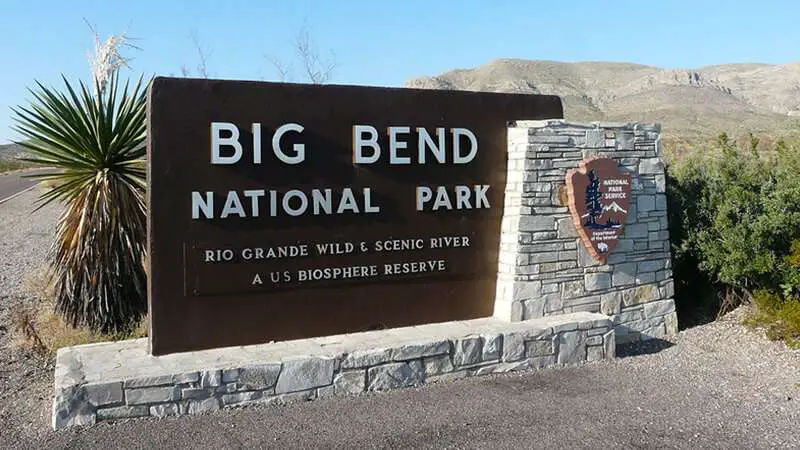
Are you planning a trip to the Big Bend area?
Big Bend National Park is an outdoor adventure haven with a distinct ecosystem that includes a desert, mountain range, and river region. It’s the largest national Park in Texas.
Big Bend National Park in Texas is a great place to see the night sky in the United States. Big Bend is known for its beautiful scenery, and its clear night skies make it a great place for people and astrophotographers.
Because the park is far from big towns, there isn’t much light pollution there. This makes it possible to see amazing things in the sky. The park’s efforts to keep its natural darkness have led to it being named an International Dark Sky Park, so its beautiful night time views will be preserved. People can see how bright the Milky Way is, how many stars shine, and even things like meteor showers and outstanding formations.
Whether you’re interested in astronomy or just want to meet the stars magically, Big Bend National Park will give you an unforgettable and complete dark sky experience.

By Nick Edwards
Managing Director, Snowfinders
Here you’ll find a place away from developed urban areas for constellation spotting and the heavenly views of the Milky Way. Ever wondered if all the stars you can see are in the Milky Way?
Nature lovers and stargazers are attracted to Big Bend National Park because of the diverse landscape, nurturing wildlife, and impeccable stargazing opportunities. Its remote location, dark skies, and low light pollution make it an excellent location for stargazing.
For more info, read my article on the negative effects of light pollution.
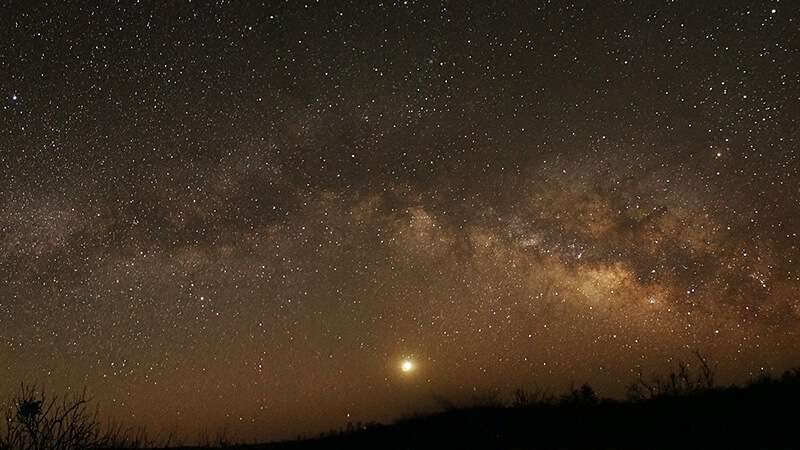
The famous Big Bend National Park night sky earned its International Dark Sky Park status from the International Dark-Sky Association in 2012.
This Park has the designation of Dark Sky Park because of its remote location, low population, and measures to diminish light pollution. The Big Bend night sky is one of the darkest skies of any national park in the other 48 states of the United States.
Due to its dark skies, you might see countless stars shining on clear nights. The lack of visible lights indicating a town or a house makes this Park an excellent place for stargazing. Big Bend offers the best stargazing in Texas.
Big Bend National Park and its neighbor, Big Bend Ranch State Park, are located in West Texas in the Chihuahuan Desert. The grandeur of the Rio Grande River surrounds these famous stargazing destinations.
The nearest airports, located a considerable distance from Big Bend National Park, are Midland/Odessa and El Paso. The nearest airport is Midland/Odessa.
WHEN IS THE BEST TIME TO VISIT BIG BEND NATIONAL PARK?
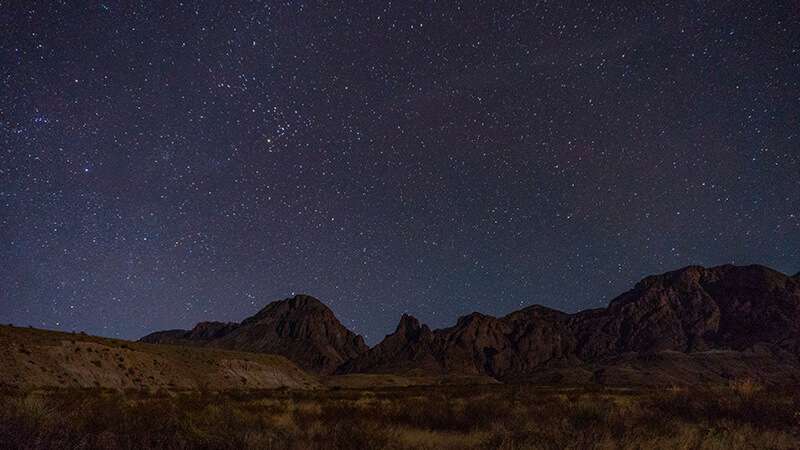
The best time to go stargazing is the days before and after the new moon when there is no moon. During this phase of the moon, the stars look brighter and provide a heavenly view.
It would help if you avoided times when the full moon is present in the sky at night.
For a clear and stunning view of stargazing, look around two after sunset or two hours before sunrise. During this “astronomical night,” you will find the darkest night skies.
The most suitable time of the year to visit Big Bend National Park is Fall or Spring. May through September is the rainy season at Big Bend, which means a higher probability of floods and thunderstorms.
WHERE IS THE ENTRANCE TO BIG BEND NATIONAL PARK?
Since Big Bend National Park is one of the most remote parks in North America, it can sometimes be a challenge to find the entrance to this desolate Park.
This national Park has two entrances and three main routes to reach them.
- US-385 south from Marathon is the quickest route when arriving from points east. This route leads to the north entrance at Persimmon Gap after about 64 km, then another 48 km south to the park headquarters.
- TX-118 south from Alpine is the fastest route from the west. The west entrance to Big Bend Park is at Maverick Junction; it is nearly 121 km to this point and then another 40 km east to the park headquarters.
- Ranch Road 170, east of the Presidio is the fastest route if you’re coming from Mexico. This road follows the Rio Grande River. Ranch Road 170 is similar to a roller coaster ride and can get very steep.
DOES IT SNOW AT BIG BEND NATIONAL PARK?
Wintertime snowfall rarely occurs in Big Bend National Park.
If you visit Big Bend National Park in December, you’ll scarcely see snowfall happening here. Snow falls here once or twice in December above an elevation of 3,500 feet.
CAN YOU VISIT BIG BEND NATIONAL PARK AT NIGHT?
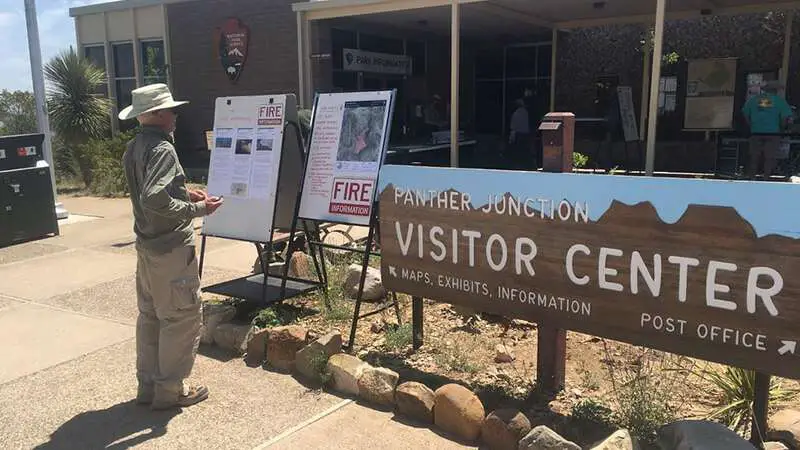
Big Bend National Park is open at night throughout the year. The gates do not close. However, the five visitor centers are only open during regular business hours.
Be careful driving through Big Bend at night. Suppose you’re planning any backcountry or river use. In that case, you must stop at the park headquarters and visitor center at Panther Junction. They issue backcountry permits at this visitor center.
IS BIG BEND NATIONAL PARK SAFE?
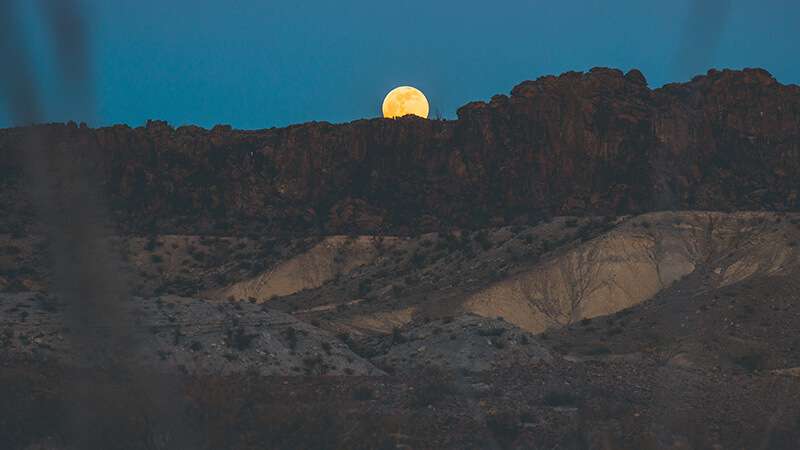
You’ll be OK staying on the main roads and paths for star gazing in Big Bend.
The most anticipated dangers in this mountainous Park are dehydration, heat exhaustion, getting lost, theft from vehicles, and the fear of wild animals such as mountain lions, black bears, bobcats, and rattlesnakes.
To keep yourself safe when stargazing Big Bend National Park, always stay on designated trails and out of closed areas.
FREE STARGAZING CHECKLIST
My 5-page Stargazing Checklist will enhance your astronomical observations.
Follow this free checklist to navigate the night sky with confidence, clarity, and a sense of preparedness for a rewarding stargazing experience.

HOW SHOULD YOU GO STARGAZING IN BIG BEND NATIONAL PARK?
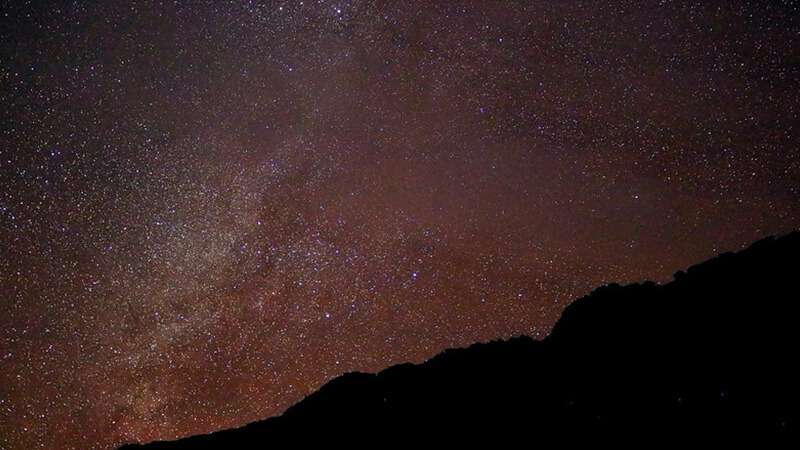
Big Bend National Park has some of the darkest skies in the region.
Many enthusiast stargazers, nature lovers, and astronomers visit this Park for a magical stargazing experience.
Big Bend is an International Dark Sky Park. It has taken a solid stance to eradicate light pollution, thus preserving night skies for an optimal view of twinkling stars.
Here you’ll see more than 2,000 stars on a moonless night, which is ten times more than what you might be used to seeing at home.
PLAN A TRIP TO SEE THE STARS
The first step of a stargazing tour in this dark sky park is selecting the right time for beholding the magical Milky Way. When you’re planning a stargazing trip, keep in mind the moon phases. The best time for stargazing is before or just after the new moon.
WHEN CAN YOU SEE THE MILKY WAY IN BIG BEND?
Big Bend National Park is a Dark Sky Park, providing many opportunities to find the Milky Way. The best time to see the Milky Way is during astronomical night. This is about 2 hours after sunset and 2 hours before sunrise. This is the darkest part of the night. The Milky Way is a gorgeous sight in the dark skies of Big Bend.
SUGGESTED ITINERARIES TO MAKE YOUR STARGAZING TRIP MEMORABLE
First-time visitors to this Park without a detailed Big Bend itinerary often need clarification on the vast area of the Park and the numerous opportunities it provides.
DAY TRIP
A one-day itinerary includes a tour along the Ross Maxwell Scenic Drive and a stop at the Chisos Basin. This drive would lead to Santa Elena Canyon, one of the most scenic spots in this national Park
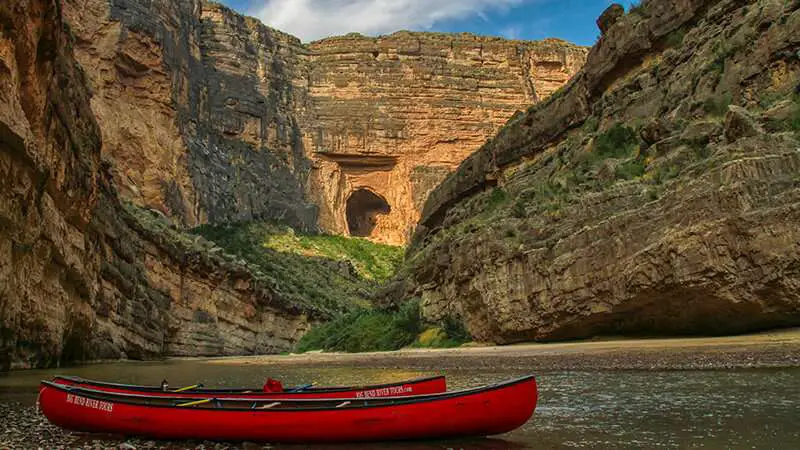
THREE-DAY ITINERARY
You can explore Big Bend Park with a relaxed mind when you have three days to spend in this Dark Sky Park.
Enjoy the Ross Maxwell Scenic Drive, including a short hike into Santa Elena Canyon. Drive to Rio Grande Village for amazing views of the Chihuahuan Desert Nature Trail.
At the end of this road is the Boquillas Canyon Trail, which leads you to the entrance of this impressive canyon.
WEEK-LONG ITINERARY
While following this itinerary, you’ll have plenty of time to spend in Big Bend National Park. You might explore the areas and trails mentioned above more thoroughly.
BIG BEND NATIONAL PARK’S BEST LOCATIONS TO STARGAZE
Big Bend National Park has one main lodge and four campgrounds, so you can stay overnight to see stars in this Dark Sky Park with some of the least light pollution in the US.
FOSSIL DISCOVERY EXHIBITION
The Fossil Discovery Exhibit is a short trail with a decent view of the Chihuahuan Desert and some interpretive signs about fossil discoveries.
The trail continues to a small overlook that is worth seeing. The Fossil Discovery Exhibit is a beautiful place to learn about the Park’s prehistory.
You can walk up the trail to get stunning views of dazzling stars.
RIO GRANDE VILLAGE
Rio Grande Village is a campground close to the Hot Springs Historic District and the Rio Grande River, perfect for viewing constellations.
While staying here, you can get a breathtaking view of the Milky Way and shooting stars.
COTTONWOOD CAMPGROUND
Cottonwood Campground is excellent for stargazing because of its tranquility and quietness. It is a pristine oasis located in the western corner of Big Bend National Park. This campsite is less crowded than some of the other stargazing spots.
Most of the hiking trails in the Big Bend are present around Chisos Basin. Still, the best hike in Santa Elena Canyon is near Cottonwood.

CHISOS MOUNTAIN LODGE
Chisos Mountains Lodge is at the heart of the Chisos Mountain Range, adjacent to a local convenience store and gift shop.
This lodge offers a wide range of amenities and reasonably priced lodging in Big Bend Park. While staying here, you will enjoy the serenity of nature and the heavenly stars you will see in the dark skies.
DOES BIG BEND HAVE A DARK SKY FESTIVAL?
In Big Bend National Park, you can participate in the regularly scheduled night sky interpretive programs throughout the year, particularly in Winter, spring, and fall.
These programs are free, entertaining, and educational. They’re a great way to explore the night sky. Park rangers will help you use park-owned telescopes to see distant planets and star clusters.
Other ranger-led events at the Dark Sky Festival include full-moon guided hikes and meteor shower viewings.
ARE THERE GUIDED NIGHT TOURS IN BIG BEND?
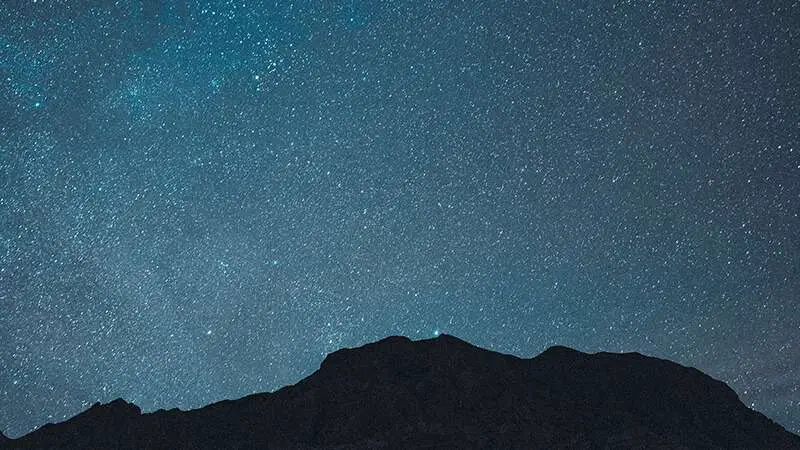
Yes, Big Bend National Park offers ranger-led stargazing programs throughout the year. These programs are a great way to learn more about the night sky and see the stars up close, even if you are new to stargazing.
During these programs, park rangers lead small groups on a night sky tour, pointing out constellations, planets, and other celestial objects.
The rangers also provide telescopes and other equipment for viewing the stars. They can answer questions and help participants learn more about the night sky.
To participate in one of these programs, you must check the Park’s calendar of events to see their scheduled stargazing program. You can also contact the Park directly to inquire about stargazing programs and to make a reservation.
Overall, ranger-led stargazing programs are a great way to experience the beauty of the night sky and learn more about the universe. They are a popular activity at Big Bend National Park.
FREQUENTLY ASKED QUESTIONS
IS SUMMER A GOOD TIME TO STARGAZE AT BIG BEND NATIONAL PARK?
Summer is generally not considered the best time of year to go stargazing at Big Bend National Park.
Summer can be hot and humid, leading to hazy skies that make it difficult to see the stars.
Finding a quiet spot to set up your telescope or a secluded place to lay out a blanket and stargaze can be more difficult.
WHAT MAKES BIG NATIONAL PARK SO GREAT FOR STARGAZING?
Big Bend National Park is considered one of the best places in the United States for stargazing because of its unique location and lack of light pollution.
Located in southwestern Texas, the Park is far from major cities and other sources of light pollution, making it one of the darkest places in the lower 48 states. This makes it an ideal spot for stargazing, as it allows you to see the stars in all their glory, free from the distractions of city lights.
In addition to its dark skies, Big Bend National Park also offers a wide variety of viewing opportunities, with clear views of the horizon in all directions. This allows you to see various celestial objects, including constellations, planets, galaxies, and shooting stars.
Overall, the combination of dark skies and clear views makes Big Bend National Park an excellent destination for stargazing.
IS BIG BEND RANCH STATE PARK GOOD FOR STARGAZING?
Yes, Big Bend Ranch State Park is also an excellent place for stargazing. Located in western Texas, the Park is known for its dark skies and clear night sky views.
Like Big Bend National Park, Big Bend Ranch State Park is far from major cities and other sources of light pollution, so the skies are generally dark and free from distractions.
In addition to its dark skies, Big Bend Ranch State Park also offers a wide variety of viewing opportunities, with clear views of the horizon in all directions.
Where can I find a Big Bend stargazing forecast?
To locate a Big Bend stargazing forecast, you can readily access accurate celestial viewing predictions for the Big Bend region online. Numerous astronomy websites and apps, such as Clear Sky Chart and Dark Site Finder, provide up-to-date stargazing forecasts and light pollution maps tailored to the Big Bend area, ensuring you have the best conditions for your amateur astronomy endeavors.
When is the best time to see milky way in texas?
To catch the Milky Way at its finest in Texas, the prime time to witness this celestial spectacle is typically during the summer months, specifically from late May to early August. During this period, the Milky Way graces the Texas night skies, offering spectacular views, especially in rural, low-light pollution areas like Big Bend National Park. Plan your stargazing outings around these summer dates for an optimal experience.
Summary: Big Bend stargazing
In conclusion, a good time of year to stargaze in Big Bend National Park is Spring, Fall, or Winter.
Winter is when the skies are clear, and the air is dry. Winter is when the Park is at its least crowded, making it the perfect time to escape the hustle and bustle of everyday life and experience the beauty of the night sky.
Whether you are a seasoned stargazer or a beginner, there is something for everyone to enjoy in Big Bend National Park.
So if you are looking for an unforgettable stargazing experience, add Big Bend National Park to your list of must-see destinations. The Big Bend sky is not to be missed.
If your road trip is taking you to nearby states, read my articles on the best stargazing in Arizona, Utah, Colorado, and California. And for special locations nearby, read my articles about stargazing in Sedona, Moab, Joshua Tree National Park, and Death Valley National Park.
Additional articles from my Dark Sky Parks series you may enjoy:
- Acadia stargazing
- Anza-Borrego stargazing
- Arches National Park stargazing
- Bryce Canyon stargazing
- Capulin Volcano National Monument
- Cherry Springs State Park stargazing
- Copper Breaks State Park stargazing
- Cosmic Campground Dark Sky Sanctuary stargazing
- Death Valley stargazing
- Enchanted Rock State Natural Area
- Grand Canyon stargazing
- Great Basin stargazing
- Haleakala stargazing
- Joshua Tree stargazing
- Massacre Rim Dark Sky Sanctuary
- Olympic National Park stargazing
- Oracle State Park stargazing
- Red Rock Canyon stargazing
- Rocky Mountain National Park stargazing
- Tonopah Stargazing Park stargazing
- Yellowstone National Park stargazing
- Zion stargazing




